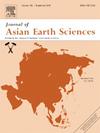Updating the timeline of faunal endemism in Balkanatolia, the biogeographic province connecting Europe, Asia and Africa
IF 2.7
3区 地球科学
Q2 GEOSCIENCES, MULTIDISCIPLINARY
引用次数: 0
Abstract
Balkanatolia is a Paleogene insular biogeographic province, spanning from southeastern Europe to the Caucasus. It is located at the crossroads of Asia, Europe, and Africa, from which it remained isolated until the late Eocene, fostering endemism, particularly among mammals. However, the timing of emergence of Balkanatolia as an independent biogeographic province remain debated due to the paucity of the fossil record and loose age constraints. Here, we refine this timing by combining magnetostratigraphy, biostratigraphy, geochronology and sedimentology to date three fossil sites of central Anatolia (Çamili Mezra, Ciçekdagi, and Bultu-Zile). These sites have yielded remains of embrithopods, a clade of large herbivorous afrotherian mammals that originated in Africa and dispersed across the Neotethys to reach Balkanatolia where they diversified. The Çamili Mezra locality yield an age spanning from 46.2 Ma to 43.5 Ma, likely around ∼ 45 Ma based on accumulation rates, the Ciçekdagi locality is dated to the very base of Chron C20r (ca. 46.2 Ma) and the Bultu-Zile locality yield overlapping 46.5 ± 1.0 Ma and 45.1 ± 0.9 Ma ages. Overall, these fossil localities are coherently dated to the early Lutetian and represent the oldest unequivocally embrithopod-bearing sites of the northern Neotethysian shores. They provide an early Lutetian minimum age for Balkanatolian endemism, its emergence as an independent biogeographic province and for the overwater dispersal of embrithopods out of Africa.
更新巴尔干半岛(连接欧洲、亚洲和非洲的生物地理省)动物特有的时间轴
巴尔卡纳托利亚是一个古近纪岛屿生物地理省,横跨欧洲东南部到高加索。它位于亚洲、欧洲和非洲的十字路口,直到始新世晚期,它一直与这些地方隔绝,形成了地方性,特别是在哺乳动物中。然而,由于化石记录的缺乏和松散的年龄限制,巴尔干托利亚作为一个独立的生物地理省出现的时间仍然存在争议。在这里,我们通过结合磁地层学、生物地层学、地质年代学和沉积学来确定安纳托利亚中部的三个化石遗址(Çamili Mezra、ciekdagi和Bultu-Zile)的年代,来完善这个时间。这些遗址出土了胚胎足类动物的遗骸,这是一种大型食草动物,起源于非洲,分散在新特提斯,到达巴尔干半岛,在那里它们多样化了。Çamili Mezra地区的年龄跨度从46.2 Ma到43.5 Ma,根据积累速率可能在~ 45 Ma左右,ciekdagi地区的年龄可追溯到Chron C20r的最底端(约46.2 Ma),而bultui - zile地区的年龄重叠在46.5±1.0 Ma和45.1±0.9 Ma之间。总的来说,这些化石地点可以一致地追溯到早期的鲁特提斯,并且代表了新特提斯北部海岸最古老的明确的胚胎类动物遗址。它们为巴尔干半岛的地方性、其作为一个独立的生物地理省的出现以及胚胎足类动物从非洲向水面扩散提供了一个早期的鲁特亚最小年龄。
本文章由计算机程序翻译,如有差异,请以英文原文为准。
求助全文
约1分钟内获得全文
求助全文
来源期刊

Journal of Asian Earth Sciences
地学-地球科学综合
CiteScore
5.90
自引率
10.00%
发文量
324
审稿时长
71 days
期刊介绍:
Journal of Asian Earth Sciences has an open access mirror journal Journal of Asian Earth Sciences: X, sharing the same aims and scope, editorial team, submission system and rigorous peer review.
The Journal of Asian Earth Sciences is an international interdisciplinary journal devoted to all aspects of research related to the solid Earth Sciences of Asia. The Journal publishes high quality, peer-reviewed scientific papers on the regional geology, tectonics, geochemistry and geophysics of Asia. It will be devoted primarily to research papers but short communications relating to new developments of broad interest, reviews and book reviews will also be included. Papers must have international appeal and should present work of more than local significance.
The scope includes deep processes of the Asian continent and its adjacent oceans; seismology and earthquakes; orogeny, magmatism, metamorphism and volcanism; growth, deformation and destruction of the Asian crust; crust-mantle interaction; evolution of life (early life, biostratigraphy, biogeography and mass-extinction); fluids, fluxes and reservoirs of mineral and energy resources; surface processes (weathering, erosion, transport and deposition of sediments) and resulting geomorphology; and the response of the Earth to global climate change as viewed within the Asian continent and surrounding oceans.
 求助内容:
求助内容: 应助结果提醒方式:
应助结果提醒方式:


